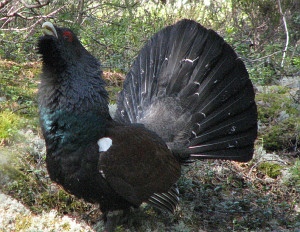
Capercaillie (Photo: Terje Asphaug)
The birds are vulnerable to disturbance from people and dogs. That can be particularly apparent where capercaillie use habitat in heavily visited parts of the countryside.
One area affected at busy times is the Loch Lomond islands, which will now see new signs strategically placed to educate people about capercaillie. It is hoped this will avoid further disturbance issues at five islands within Loch Lomond.
Visitors enjoying the stunning scenery will be asked to avoid the birds’ habitat during the breeding season and to properly control their dogs.
The fresh initiative comes from the Loch Lomond and Trossachs National Park Authority (NPA), Scottish Natural Heritage (SNH), and Strathclyde Police.
Two Rangers are patrolling the islands within Loch Lomond throughout the summer season. Police are also on hand to take action if necessary.
The island rangers are patrolling selected areas during the weekends with a dedicated patrol boat.
Signs have been erected at key launch locations such as Luss Pier; the islands, and flyers distributed to boat users and other water pleasure-seekers.
The action is required as the Loch Lomond capercaillie population is isolated from other Scottish populations, with no immediate likelihood of numbers being strengthened from further north.
Alan McDonnell, SNH’s operations manager, said: “We are delighted to be taking part in this innovative scheme which we hope will result in increased education and awareness for users and less disturbance to the capercaillie on the Loch Lomond islands. This is the latest in a range of initiatives designed to help the capercaillie establish a firmer foothold throughout Scotland.
“Capercaillie are under great pressure nationally due to a range of factors which mean that the species has a far from secure future. These include climate change, which can make poor weather at key times more common, low habitat quality and availability, predation, and disturbance of breeding birds and young chicks.
“We also know that recreational users may unwittingly cause disturbance by allowing dogs to roam uncontrolled through important capercaillie areas during the sensitive breeding season. We hope that the signs which are highly visible will educate people about the plight of this most magnificent bird.”
Guy Keating, National Park Ranger Service Manager, said: “We are pleased to be working in partnership with SNH to help conserve this precious population of capercaillie.
“The additional SNH funding has meant we have been able to recruit two dedicated seasonal rangers to patrol the islands and engage with visitors during the summer, and we are already seeing the benefits of this approach. The majority of visitors have been receptive towards the rangers and the popular camping spots look much better than they did this time last year.
“In addition, the new signs around the islands contain important conservation messages and our rangers will provide practical advice on how visitors can play their part in protecting the special qualities of these fantastic islands. Also Strathclyde police officers will be joining ranger patrols to ensure the laws protecting these vulnerable habitats are not being broken.”
